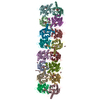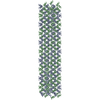[English] 日本語
 Yorodumi
Yorodumi- EMDB-5737: Structure of an RNA silencing complex of the CRISPR-Cas immune system -
+ Open data
Open data
- Basic information
Basic information
| Entry | Database: EMDB / ID: EMD-5737 | |||||||||
|---|---|---|---|---|---|---|---|---|---|---|
| Title | Structure of an RNA silencing complex of the CRISPR-Cas immune system | |||||||||
 Map data Map data | Helical reconstruction of the Cmr4-Cmr5 filament | |||||||||
 Sample Sample |
| |||||||||
 Keywords Keywords | Helical filament | |||||||||
| Function / homology |  Function and homology information Function and homology informationdefense response to virus /  endonuclease activity / endonuclease activity /  Hydrolases; Acting on ester bonds / Hydrolases; Acting on ester bonds /  RNA binding / RNA binding /  cytoplasm cytoplasmSimilarity search - Function | |||||||||
| Biological species |    Pyrococcus furiosus (archaea) Pyrococcus furiosus (archaea) | |||||||||
| Method | helical reconstruction /  cryo EM / Resolution: 16.0 Å cryo EM / Resolution: 16.0 Å | |||||||||
 Authors Authors | Spilman MS / Cocozaki AI / Hale C / Shao Y / Ramia NF / Terns R / Terns M / Li H / Stagg SM | |||||||||
 Citation Citation |  Journal: Mol Cell / Year: 2013 Journal: Mol Cell / Year: 2013Title: Structure of an RNA silencing complex of the CRISPR-Cas immune system. Authors: Michael Spilman / Alexis Cocozaki / Caryn Hale / Yaming Shao / Nancy Ramia / Rebeca Terns / Michael Terns / Hong Li / Scott Stagg /  Abstract: Bacterial and archaeal clustered regularly interspaced short palindromic repeat (CRISPR) loci capture virus and plasmid sequences and use them to recognize and eliminate these invaders. CRISPR RNAs ...Bacterial and archaeal clustered regularly interspaced short palindromic repeat (CRISPR) loci capture virus and plasmid sequences and use them to recognize and eliminate these invaders. CRISPR RNAs (crRNAs) containing the acquired sequences are incorporated into effector complexes that destroy matching invader nucleic acids. The multicomponent Cmr effector complex cleaves RNA targets complementary to the crRNAs. Here, we report cryoelectron microscopy reconstruction of a functional Cmr complex bound with a target RNA at ~12 Å. Pairs of the Cmr4 and Cmr5 proteins form a helical core that is asymmetrically capped on each end by distinct pairs of the four remaining subunits: Cmr2 and Cmr3 at the conserved 5' crRNA tag sequence and Cmr1 and Cmr6 near the 3' end of the crRNA. The shape and organization of the RNA-targeting Cmr complex is strikingly similar to the DNA-targeting Cascade complex. Our results reveal a remarkably conserved architecture among very distantly related CRISPR-Cas complexes. | |||||||||
| History |
|
- Structure visualization
Structure visualization
| Movie |
 Movie viewer Movie viewer |
|---|---|
| Structure viewer | EM map:  SurfView SurfView Molmil Molmil Jmol/JSmol Jmol/JSmol |
| Supplemental images |
- Downloads & links
Downloads & links
-EMDB archive
| Map data |  emd_5737.map.gz emd_5737.map.gz | 460.1 KB |  EMDB map data format EMDB map data format | |
|---|---|---|---|---|
| Header (meta data) |  emd-5737-v30.xml emd-5737-v30.xml emd-5737.xml emd-5737.xml | 10.3 KB 10.3 KB | Display Display |  EMDB header EMDB header |
| Images |  emd_5737_1.jpg emd_5737_1.jpg | 65.6 KB | ||
| Archive directory |  http://ftp.pdbj.org/pub/emdb/structures/EMD-5737 http://ftp.pdbj.org/pub/emdb/structures/EMD-5737 ftp://ftp.pdbj.org/pub/emdb/structures/EMD-5737 ftp://ftp.pdbj.org/pub/emdb/structures/EMD-5737 | HTTPS FTP |
-Related structure data
- Links
Links
| EMDB pages |  EMDB (EBI/PDBe) / EMDB (EBI/PDBe) /  EMDataResource EMDataResource |
|---|
- Map
Map
| File |  Download / File: emd_5737.map.gz / Format: CCP4 / Size: 3.3 MB / Type: IMAGE STORED AS FLOATING POINT NUMBER (4 BYTES) Download / File: emd_5737.map.gz / Format: CCP4 / Size: 3.3 MB / Type: IMAGE STORED AS FLOATING POINT NUMBER (4 BYTES) | ||||||||||||||||||||||||||||||||||||||||||||||||||||||||||||||||||||
|---|---|---|---|---|---|---|---|---|---|---|---|---|---|---|---|---|---|---|---|---|---|---|---|---|---|---|---|---|---|---|---|---|---|---|---|---|---|---|---|---|---|---|---|---|---|---|---|---|---|---|---|---|---|---|---|---|---|---|---|---|---|---|---|---|---|---|---|---|---|
| Annotation | Helical reconstruction of the Cmr4-Cmr5 filament | ||||||||||||||||||||||||||||||||||||||||||||||||||||||||||||||||||||
| Voxel size | X=Y=Z: 2.78 Å | ||||||||||||||||||||||||||||||||||||||||||||||||||||||||||||||||||||
| Density |
| ||||||||||||||||||||||||||||||||||||||||||||||||||||||||||||||||||||
| Symmetry | Space group: 1 | ||||||||||||||||||||||||||||||||||||||||||||||||||||||||||||||||||||
| Details | EMDB XML:
CCP4 map header:
| ||||||||||||||||||||||||||||||||||||||||||||||||||||||||||||||||||||
-Supplemental data
- Sample components
Sample components
-Entire : Cmr4-Cmr5 filament
| Entire | Name: Cmr4-Cmr5 filament |
|---|---|
| Components |
|
-Supramolecule #1000: Cmr4-Cmr5 filament
| Supramolecule | Name: Cmr4-Cmr5 filament / type: sample / ID: 1000 / Oligomeric state: helical filament / Number unique components: 2 |
|---|---|
| Molecular weight | Theoretical: 520 KDa |
-Macromolecule #1: Cmr4
| Macromolecule | Name: Cmr4 / type: protein_or_peptide / ID: 1 / Recombinant expression: Yes |
|---|---|
| Source (natural) | Organism:    Pyrococcus furiosus (archaea) Pyrococcus furiosus (archaea) |
| Recombinant expression | Organism:   Escherichia coli (E. coli) Escherichia coli (E. coli) |
| Sequence | UniProtKB: CRISPR system Cmr endoribonuclease Cmr4 |
-Macromolecule #2: Cmr5
| Macromolecule | Name: Cmr5 / type: protein_or_peptide / ID: 2 / Recombinant expression: Yes |
|---|---|
| Source (natural) | Organism:    Pyrococcus furiosus (archaea) Pyrococcus furiosus (archaea) |
| Recombinant expression | Organism:   Escherichia coli (E. coli) Escherichia coli (E. coli) |
| Sequence | UniProtKB: CRISPR system Cmr subunit Cmr5 |
-Experimental details
-Structure determination
| Method |  cryo EM cryo EM |
|---|---|
 Processing Processing | helical reconstruction |
| Aggregation state | filament |
- Sample preparation
Sample preparation
| Concentration | 2 mg/mL |
|---|---|
| Buffer | pH: 7.5 / Details: 20 mM Tris-HCl, 100 mM NaCl |
| Grid | Details: C-flat 2/2 400 mesh holey carbon grid |
| Vitrification | Cryogen name: ETHANE / Chamber humidity: 100 % / Chamber temperature: 93 K / Instrument: FEI VITROBOT MARK IV Method: Plasma clean grids for 5 seconds, apply 3 uL sample, and blot for 4 seconds before plunging. |
- Electron microscopy
Electron microscopy
| Microscope | FEI TITAN KRIOS |
|---|---|
| Electron beam | Acceleration voltage: 120 kV / Electron source:  FIELD EMISSION GUN FIELD EMISSION GUN |
| Electron optics | Illumination mode: SPOT SCAN / Imaging mode: BRIGHT FIELD Bright-field microscopy / Cs: 2.7 mm / Nominal defocus max: 5.0 µm / Nominal defocus min: 0.5 µm / Nominal magnification: 59000 Bright-field microscopy / Cs: 2.7 mm / Nominal defocus max: 5.0 µm / Nominal defocus min: 0.5 µm / Nominal magnification: 59000 |
| Sample stage | Specimen holder: Nitrogen cooled / Specimen holder model: FEI TITAN KRIOS AUTOGRID HOLDER |
| Temperature | Average: 94 K |
| Alignment procedure | Legacy - Astigmatism: Objective lens astigmatism was corrected at 120,000 times magnification |
| Date | Sep 10, 2012 |
| Image recording | Category: CCD / Film or detector model: GATAN ULTRASCAN 4000 (4k x 4k) / Number real images: 268 / Average electron dose: 15 e/Å2 |
| Experimental equipment |  Model: Titan Krios / Image courtesy: FEI Company |
- Image processing
Image processing
| CTF correction | Details: Phase flip each particle |
|---|---|
| Final reconstruction | Applied symmetry - Helical parameters - Δz: 29.3 Å Applied symmetry - Helical parameters - Δ&Phi: 48 ° Algorithm: OTHER / Resolution.type: BY AUTHOR / Resolution: 16.0 Å / Resolution method: FSC 0.5 CUT-OFF / Software - Name: EMAN, IHRSR |
| Details | Helical reconstruction used IHRSR software package combined with EMAN and in-house software |
 Movie
Movie Controller
Controller












